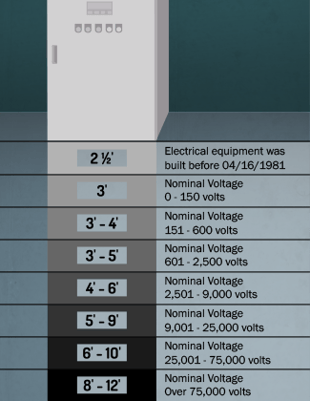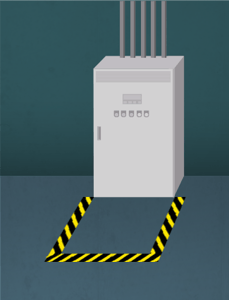Electrical Panel Compliance with Floor Marking
03
February,
2023
3 MINUTE READ

Electrical panels are an integral part of large and small facilities throughout the United States. The panels control the energy that keeps machines operating, lights buzzing, and computers running, yet they are easy to ignore during the day-to-day routine. The National Institutes of Health (NIH) found these shocking numbers related to electrical hazards:
- 400 high-voltage electrical injuries per year
- 30,000 non-fatal shock incidents per year
- 1,000 deaths per year
It's important to know OSHA electrical panel clearance requirements for maintaining clear, safe areas around electrical panels and how to communicate those boundaries best with effective floor marking.
Complying with OSHA Regulations for Electrical Panel Clearance
OSHA electrical panel clearance requirements (29 CFR 1910.303) includes a section for establishing and maintaining space around electrical panels and other systems that require servicing, adjustments, or maintenance while energized.
Here's a broad breakdown of electrical panel clearance space requirements when planning around electrical panels:

- Sufficient access and working space must be provided, and properly marked, around an electrical panel to meet floor marking standards
- The width of the space in front of an electrical panel must be the width of the equipment or 30 inches, whichever is wider
- The working space must allow for a hinged panel or equipment door to open at a 90 degree angle
- The vertical space must extend from the grade, floor, or platform immediately in front of the electrical panel to either:
- 6 feet, 3 inches above the ground (for buildings or areas constructed before August 13, 2007)
- 6 1/2 feet above the ground (for buildings constructed after August 13, 2007)
- The clear working space — shown with floor marking tape — in front of an electrical panel (or piece of electrical equipment) must be:
- 2 1/2 feet if the electrical equipment was built before April 16, 1981
- 3 feet when the nominal voltage is between 0 and 150 volts
- 3 to 4 feet when the nominal voltage is between 151 and 600 volts
- 3 to 5 feet when the nominal voltage is between 601 and 2,500 volts
- 4 to 6 feet when the nominal voltage is between 2,501 and 9,000 volts
- 5 to 9 feet when the nominal voltage is between 9,001 and 25,000 volts
- 6 to 10 feet when the nominal voltage is between 25,001 and 75,000 volts
- 8 to 12 feet when the nominal voltage is over 75,000 volts
Note: The exact working space measurements depend on voltage, insulation, and exposed live and ground parts that may be present. Consult Table S-1 and S-2 in 29 CFR 1910.303 for more detailed guidance on boundary measurements. These boundaries can be properly marked with the right floor marking tape.
OSHA lists specific requirements for switchboards, panelboards, and distribution boards that control a building's light and power circuits. Those installations must follow these requirements:
- The vertical space must extend from the grade, floor, or platform immediately in front of the electrical panel to a structural ceiling or 6 feet, whichever is lower
- The space equal to the width and depth of the equipment must be kept clear, unless it's used to protect against condensation, leaks, sprinklers, and other damage
It's best to use hazard floor marking tape to properly set boundaries to meet these requirements.
Additional Tips for Electrical Panel Compliance
OSHA electrical panel clearance maintains a few rules when pipes, ducts, and other equipment may be present near electrical panels. Those rules include the following:
- The area of the electrical equipment should be kept clear of any other material, equipment, piping, or ducting systems
- This clear space should include the entire footprint of the equipment, and extend upwards to six feet above the top of the equipment (or to the structural ceiling, if that is lower)
- Pipes, ducts, and other equipment may not be located in this "headroom" space unless there is effective physical protection in place, including drip-proofing or leak-proofing
Establish Boundaries with Floor Marking
Once you've established boundaries around an electrical panel, it's time to consider how to best communicate those borders. OSHA offers no requirements for specific floor marking colors or requirements, but some best practices can guide your decision-making process.
Here's how floor marking tape can make those borders clear and keep workers safe:

- Striped hazard floor marking tape: The bright colors and stark contrast of striped hazard tape make it easy to see from a distance. Most facilities use red-and-white striped tape or black-and-yellow striped tape for outlining clearance areas around electrical equipment
- Solid color floor marking: Solid floor marking tape can denote areas when striped floor marking is used elsewhere as part of a wider color-coded system; yellow floor marking typically signals caution and indicates pedestrian paths and work areas, while white tape is most often used for general purposes
- Floor signs: Use large, durable floor signs to alert workers to electrical panels, and remind them to keep the area clear; this can clarify and reinforce the messages communicated with floor marking tape
Floor Marking Resources from DuraLabel
DuraLabel’s free Floor Marking Instant Action Guide helps you create safe pathways for pedestrians and vehicular traffic, reduce confusion and improve efficiency, and guide workers to tools they need. Request your free Floor Marking Instant Action Guide. Give us a call today at 1-888-326-9244 and one of our experts will guide you through the process.
DuraLabel's floor marking solutions not only enhances safety but also contributes to the overall efficiency and organization of your workspace. Take the next step in elevating your workplace safety standards by exploring DuraLabel's floor marking products today.
Read Next:
| Our Floor Marking Instant Action Guide, Free! Learn more about common uses for various types of floor marking tape with our |
RELATED RESOURCES

OSHA & ANSI Hard Hat Requirements
Around construction sites, hard hats are the best way to protect yourself from permanent, life-changing ...
Read
Hard Hat Requirements
OSHA/ANSI Hardhat Requirements 68,000 injuries in 2020 required an absence from work 1,000 workers killed ...
Read
How to Choose the Right Floor Marking Tape
Floor marking tape is designed to inform workers when they are approaching a safety hazard. OSHA requires ...
Read.png)





